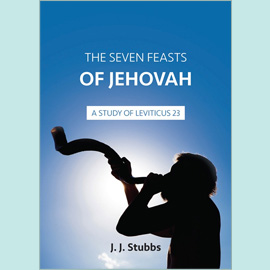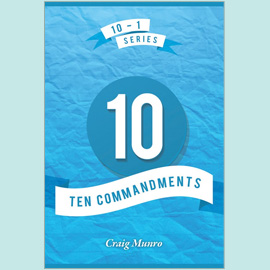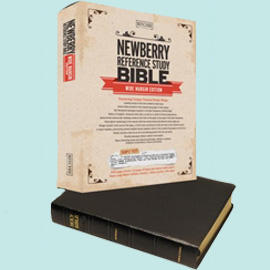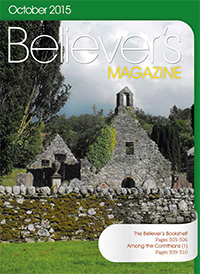In contrast to the two bronze vessels in the Outer Court, the vessels in the Holy Place were constructed with gold. The Golden Lampstand was made of one solid gold piece and the Table of Shewbread and the Altar of Incense were of wood overlaid with gold. The vessels in the Outer Court were designed to deal with sin and ceremonial defilement. The vessels within the Holy Place were designed to manifest God and His glory. The vessels in the Holy Place were made of gold to express this change in purpose, gold being more attractive and costly than bronze.
The Table of Shewbread (Ex 25.23-30; Lev 24.5-9)
The table is the place where people share meals together. It symbolises friendship and fellowship. It speaks of kindness and hospitality. David famously refers to a table spread by the Lord in Psalm 23 even when he was surrounded by his enemies.1 In the New Testament the Lord Jesus sat at the same table as "publicans and sinners" (Mt 9.10). He sat at the table in the home in Bethany (Jn 12.2), and again with His disciples in the Upper Room before Calvary (Lk 22.21).
The Table of Shewbread emphasised that the Tabernacle was a place where man could have fellowship with God, albeit this fellowship was through the priest. The ordinary man could not approach the Holy Place.
The twelve loaves correspond to the twelve tribes. In reality thee tribes were characterised by murmuring and idolatry, but the twelve loaves emphasised what they should be. The loaves were made of fine wheat (Lev 24.5). Josephus states that they were unleavened.2 Frankincense was sprinkled on the loaves. They were renewed every week so they remained fresh. The fine wheat speaks of consistency of character; the absence of leaven speaks of holiness; and the frankincense of that which is sweet and attractive to God. God could "feed" on that which was pure, holy and sweet. If the loaves represented Israel ideally, the only one who fulfilled these ideals was the Lord Jesus Himself, the perfect Israelite. The "bread from heaven" (Ex 16.33; Jn 6.31) placed in the golden bowl hidden inside the Ark spoke only of Christ.
Each loaf was 2/10 of an ephah of flour3 which is a substantial amount. Given the dimensions of the table it has been suggested that there would not have been room for twelve large loaves in two rows of six. Some think that the word "row"4 in the AV should be translated "pile". My preference however is to see the loaves as arranged in rows. Even if the loaves were large they need not have been broad. Every week the priests were permitted to remove and eat the shewbread (Lev 24.5-9). So the loaves represent not only what the Lord delights in and "feeds" on, but it is also what we should feed on.
The Golden Lampstand (Ex 25.31-40; 37.17-24; 39.37)
Although the AV refers to this vessel as the candlestick5 it is perhaps better to speak of it as the Lampstand since there was no wax used in it. It gave light from seven lamps each fed by olive oil and each with a wick. The Lampstand was a highly ornate vessel and evidently meant to be beautiful. Almond flowers and buds were carved or beaten into the gold. The Lampstand stood like a tree before the Veil. The cherubim embroidered on the Veil and the "tree" emanating light made the scene reminiscent of Eden. The cups into which the oil was poured seem to have been upturned bowls carved to look like petals. Creation was represented in the Tabernacle in its various forms. The almonds represented the botanic creation, the cherubim the angelic creation, the hides covering the Tabernacle the maritime creation, the metals represented the mineral creation.
The Bible does not give any indication of its size or dimensions. The Lampstand stood (Ex 26.35) on the south side of the Holy Place, to the priest's left as he faced the Ark.
Apart from the Lampstand there would have been no light for the priest as he offered incense or handled the bread. The outer Veil cut off the natural light. The seven lamps ensured that there was adequate light to work with. The golden boards that lined the Tabernacle must have reflected the light of the Lampstand and made it a beautiful place in which to serve.
The Lampstand had one central stem and six branches so that there were seven lamps in total. Seven is perhaps the most important number in Scripture. It is linked with the idea of completion or perfection. There are seven days in a week, and the seventh day, the Sabbath, was the day in which God completed His work. The seven Feasts of Jehovah (Lev 23) cover the whole religious cycle of a year. The seven churches of Asia (Rev 2-3) represent the cycle of church testimony. The Lampstand therefore represents perfect illumination. The flame was supplied by oil which sat in little cups, and in the oil was a wick which required to be lit and trimmed by the priests. The oil was produced by beating olives and catching the oil they produced. It had to be pure oil, free of any impurities. Oil in Scripture was used as fuel for lamps, in baking or cooking, its soothing properties made it suitable for medicinal purposes (Lk 10.34; Mk 6.13), it was employed to soften and enhance skin (Ps 104.15) and for other cosmetic purposes. It was used symbolically to mark the appointment of kings and prophets. The word "anoint" (māšah.) means to pour or smear oil on a person or object. The Messiah (māšîah.) is the anointed one.
The light was fed with pure oil. Oil is linked in Scripture with the Holy Spirit as the unseen source of energy and power. The priests had the daily task of replenishing the oil and trimming the wicks that burned in the bowls holding the oil. We do not have any dimensions for the lampstand. All we know is what it was made of, how it was ornamented, and where it stood. It shares this feature with the laver. In addition, the Lampstand, like the Laver and the Mercy Seat, was made of solid metal.
The Altar of Incense (Ex 27.1-8)
Also known as the Golden Altar, this item in the Tabernacle was made of shittim wood overlaid with gold. It stood before the Veil. It was a far smaller altar than the Brazen Altar that stood in the Court.6 It was not used to offer animals but to burn incense.
Coals from the Brazen Altar were taken into the Holy Place in a censer, a small vessel that contained the live coals, and placed on the top of the altar. The priest would pour a bowl of incense on the live coals atop the altar. Thereupon a cloud of incense would rise up. Unlike the smoke of the altar which would rise to heaven, the incense would fill the Holy Place.
Incense represents the prayers of the people. The connection between prayer and incense is made clear in Psalm 141.2, Revelation 5.8 and 8.3. This indicates that prayers are not demanding and tiresome to God but pleasing to Him. Since anything emanating from the heart of man is to an extent tainted, the altar was purified yearly by an act of atonement (Ex 30.10).
The book of Exodus begins the instructions for the building of the Tabernacle in chapter 25 with the most important vessel, the Ark, followed by the Table and the Candlestick. There is no mention of the Golden Altar until chapter 30. Why are all three not mentioned together? This may be because that Altar served a different purpose. The other two vessels represented the Lord and His ability to illuminate and provide for His people. The Golden Altar by contrast depicts man reaching out to God through prayer. Although it is not described in Exodus 25 it stood beside the Ark, separated only by the Veil. If its importance is determined by its proximity to the Ark, it ranks before the other two vessels in the Holy Place.
To be continued.
1 The altar is described at times as a "table" (Mal 1.7; Ezek 44.16). This may suggest that the offerings provided that upon which God "fed" (Lev 21.6) and which in turn provided food for the priests.
2 Antiquities of the Jews Book 3, ch 6, para. 6.
3 Each loaf was 2/10 of an ephah which is about 4.4 litres or just under a gallon.
4 Heb. ārak - lit. "to set or arrange in order."
5 Heb. menorah.
6 The Golden Altar was square and about 3 feet high.









